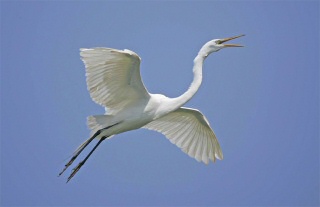|
Trail Guides
|
The Wetlands Institute
|
5
 
|
1075 Stone Harbor Blvd, Stone Harbor, NJ 08247
Phone: (609) 368-1211
www.wetlandsinstitute.org
Turn Right out of the parking lot
onto 2nd St. After 1.5 miles, turn Left onto 96th St./Stone Harbor Blvd. and cross over the drawbridge out of Stone Harbor. The Wetlands Institute is on the left, approximately 1⁄2 mile beyond the bridge. Map
A slow, quiet walk along the wide path into the salt marsh can often result in very good looks at Clapper Rail, Seaside Sparrow, and in spring, foraging Whimbrel.
 |
| Great Egret | Kevin Karlson |
| |
| | The Wetlands Institute is the perfect place to become acquainted with the ecology of intertidal wetlands. The large facility is surrounded by native spartina grass in the midst of the Cape May Wetlands Wildlife Management Area, also known as The Great Salt Marsh. The Institute provides easy access to parking, walking trails, and a host of interpretative programs. Many common and uncommon
creatures can be found along the short walking paths, and you may learn more about them inside at the Institute’s interpretive displays. The Wetlands Institute is always worth a visit by
families and casual tourists, as well as more advanced wildlife and birdwatchers.
the tide pools located immediately adjacent to the parking lot where migrant shorebirds are common, particularly at high tide in late spring through early autumn.
The Wetlands Institute provides an ideal place to scan the salt marsh for wintering raptors and waterfowl. Impressive numbers of Brant
congregate in the colder months, and a walk down the path to the tidal channel can often
produce diving ducks and wintering shorebirds.
Spring is one of the busiest times as Osprey, herons, egrets and ibis return to the area in numbers to set up their nesting territories. Plants around the center attract avian migrants, and several unusual species have been spotted right from the parking lot in recent years.
The marsh is alive with biting insects, but by the middle of the season shorebirds can be found in good numbers on the same ponds that harbored them in spring. The Institute
supports the Terrapin Recovery/Conservation Project which seeks to protect adult Diamondback Terrapins as they cross the road looking for nesting sites. Terrapins of all ages
are on exhibit in the center.
Fall is a great time to stop at the Wetlands Institute, with almost anything being possible. Falcons and other raptors are often seen in migration, and the wildlife gardens around the center were planted to attract butterflies,
hummingbirds and migrant songbirds.
|
|
|